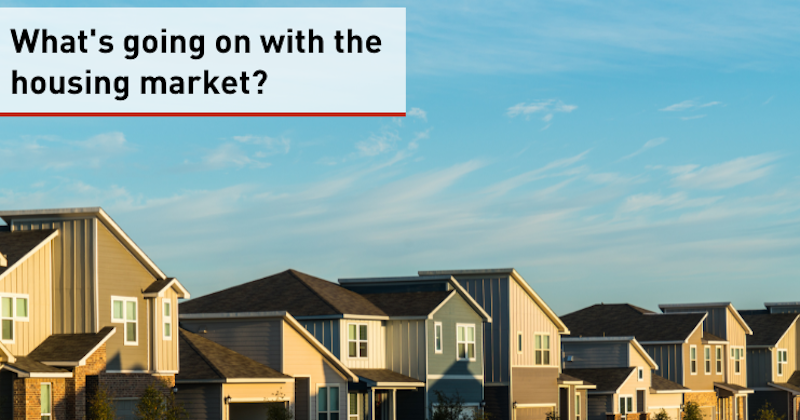Challenges to Homeownership


When the fed raised interest rates in March of 2022, the average 30-year mortgage didn’t go above 4% since 2019, according to Freddie Mac data. They continued to climb in tandem with the Fed’s hikes until November 2022, when mortgage rates peaked at 7.08%. Since then, rates have stayed above 6% and at the time of writing a 30-year Fixed Rate Mortgage is 6.78%. Traditionally , a hike in mortgage rates would mean the housing market would cool down resulting in prices dropping but that hasn’t necessarily been the case1. Median Home prices have experienced a slight decrease, down .9% from this time last year, but inventory and mortgage rates are keeping pressure on the prices. “While affordability continues to challenge buyers, the lack of inventory is likely to be the key issue for eager buyers as it keeps upward pressure on prices while limiting buyer choice,” notes Danielle Hale, chief economist for Realtor.
The housing market's remarkable resilience amidst rising mortgage rates can also be attributed to various economic factors, as highlighted by experts like Charles Dougherty, senior economist at Wells Fargo. “The Fed’s monetary policy is one of many factors that influences mortgages”, said Dougherty2. Other important factors are GDP growth and employment. Since Q3 2022 Real GDP has continued to grow quarter-over-quarter with the Q2 estimate 2.1% better than Q1 which speaks to the resiliency of our economy. As for the labor market, the United States is also trending positively and helps gauge the overall health of the economy. Through Q2 labor force participation has remained steady at 62.6%, this is the percentage of the population that is either working or actively looking for work1. This correlates to demand for goods and services, including real estate, despite the rise in mortgage rates.
In a recent episode of Wells Fargo’s Ask Our Economist podcast, Charles Dougherty explained that “the Fed doesn't control mortgage rates directly, but they do have a lot of influence over interest rates. And mortgage rates tend to follow the 10-year Treasury yield. And what we've seen is, as the Fed has raised interest rates, mortgage rates have gone up alongside it.” Because mortgage rates are loosely correlated to the 10-year Treasury yield this spread has widened which is something that tends to happen during periods or economic uncertainty3.
With inflation persistently above the Fed's target4, the anticipation of more rate hikes has added to the uncertainty in the economic outlook and the housing market. The market not only responds to the Fed's immediate actions but also engages in speculation about the potential trajectory of rates over the next decade.
Len Kiefer, Deputy Chief Economist at Freddie Mac, told CNN, “Long-term interest rates are anticipating not just the Fed’s next move, but the potential path for rates over the next decade. Mortgage rates may respond to the next Fed rate move, but it could seem counterfactual. For example, if the market comes to the conclusion that future rate hikes are less likely, that could put downward pressure on mortgage rates. In that case, mortgage rates could fall, even if the policy rate goes up.”5
Another crucial factor contributing to the market's peculiar behavior is the "lock-in effect" caused by the significant disparity in mortgage rates before and after the Fed's rate hikes. During the pandemic, when interest rates were near-zero, many homeowners and buyers secured mortgages at exceptionally low rates, as low as 2%. Now, with mortgage rates approaching 7%, existing homeowners are hesitant to relinquish their mortgages below 4% for significantly higher rates. This phenomenon has led to a decline in existing housing inventory.
The reality is that the housing market is still grappling with the aftermath of the Great Recession, which resulted in a decade of sluggish new home construction. The surge in demand during the pandemic, coupled with limited new construction, has further exacerbated the housing inventory shortage.
As a result of all these intricate factors, the housing market appears "odd" and resistant to the conventional response of cooling down when mortgage rates increase. Instead, it continues to face inventory challenges, maintaining pressure on home prices and making it difficult for potential buyers to find affordable options. Homebuilder sentiment is cautiously optimistic as the increase for new homes has risen in Q2 “but the quarter-point rise in mortgage rates over the past month is a stark reminder of the stop and start process the market will experience as the Federal Reserve nears the end of the ongoing tightening cycle,” said Robert Dietz, NAHB’s Chief Economist.6
 © Copyright 2024, The True Life Companies. All Rights Reserved. Website Design by Kovach Marketing. Development & Hosting by Blue Tangerine.
© Copyright 2024, The True Life Companies. All Rights Reserved. Website Design by Kovach Marketing. Development & Hosting by Blue Tangerine.